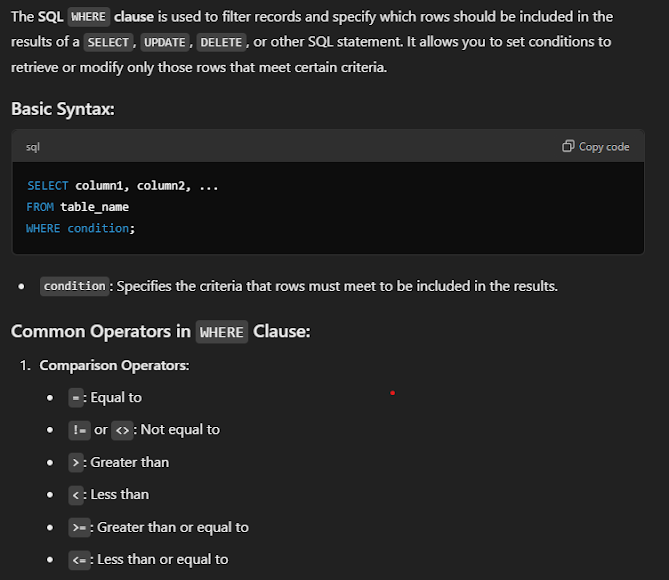1) What is SQL ?
SQL (Structured Query Language) is a standard programming language for managing and manipulating relational databases. It allows users to perform operations such as querying, inserting, updating, and deleting data. SQL is used to define the structure of data by creating and modifying tables.
 |
| SQL |
It supports various functions like data filtering, sorting, and aggregation. SQL also handles database access control, allowing for user permissions. Popular relational database systems like MySQL, PostgreSQL, and SQL Server rely on SQL. It is essential for working with structured data in a relational database format.[W3 Schools]
2) What Can SQL do?
SQL can perform a variety of functions related to databases, including:
Query data: Retrieve specific data from databases using
SELECT statements.Insert data: Add new records to a database table with the
INSERT command.Update data: Modify existing records using
UPDATE.Delete data: Remove records from tables with
DELETE.Create tables and databases: Define database structures with
CREATE TABLE and CREATE DATABASE.Manage permissions: Control user access using
GRANT and REVOKE.Join tables: Combine data from multiple tables with
JOIN operations.Aggregate data: Perform calculations on data like sum, count, or average using
GROUP BY and aggregate functions like SUM(), COUNT().[YOUTUBE.VIDEO]3) SQL Syntax :
 |
| SQL Server |
4) RDBMS :
RDBMS (Relational Database Management System) is a type of database management system that stores data in a structured format using tables (rows and columns). It allows users to:
- Store data in tables with relationships between them.
- Maintain data integrity by enforcing rules like primary keys and foreign keys.
- Perform CRUD operations: Create, Read, Update, and Delete data.
- Query data using SQL.
- Ensure data consistency through transactions.
- Control access with user permissions.
- Support relationships between tables (e.g., one-to-one, one-to-many, many-to-many).
- Popular RDBMS: MySQL, PostgreSQL, Oracle, and SQL Server.
5) Database Tables :
 |
| SQL Database |
















0 Comments